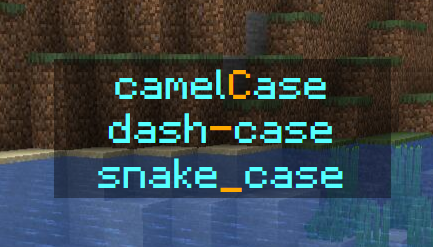YAML Guide - TheComputerGeek2/MagicSpells GitHub Wiki
Table of contents:
Introduction:
- In MagicSpells data YAML files are those with the file extension
.yml. - You can write comments like this:
#comment 1
is_true: true #comment 2
- Indentation must be done with spaces, not TAB spaces.
map:
validKey: true
validKey: false
Nodes:
A node is a key-value pair.
key: value
Node Keys:
In general, YAML keys can include spaces, but in:
- MagicSpells configuration they follow dash case.
- EffectLib configuration follows any case.

Node Values:
There are two major types of values, Scalar and Collection (lists & objects).
Scalar Values:
- Boolean can either be
trueorfalse. - Numeric can be integer or floating-point (decimal).
- String refers to text.
- If strings include special characters, they must be enclosed in quotes, if not they may be quote-less (plain). One example of special characters is the new line
\n.
- If strings include special characters, they must be enclosed in quotes, if not they may be quote-less (plain). One example of special characters is the new line
plain-string: some value
string1: "one\n1"
string2: 'two\n2'
string3: 'three "3"'
string4: "four '4'"
-
- If you need to put the same type of quotes inside quotes, you can use the character
\to escape the inner quotes, defining a valid string. Additional\can be added for each level of depth.
- If you need to put the same type of quotes inside quotes, you can use the character
string: "1 \"2\" '3' \"\\"4\\"\""
# Prints: 1 "2" '3' ""4""
- You can also write multi-line strings.
-
- You can also write a multi-line string (for readability) in the config which is parsed into a folded, single-line string.
folded: >
hello
world
# Parses into: "hello world\n"
next-node: value
-
- You can also write Blocks which keep the multi-line format by using the
|character instead of>.
- You can also write Blocks which keep the multi-line format by using the
block: |
hello
world
# Parses into: "hello\nworld\n"
next-node: value
-
- You can add indentation to the finally parsed string in one place if you'd like, after the special character.
string: |2
hello
world
# Parses into: " hello\n world\n"
-
- You'll notice these multi-line formats put the extra newline character at the end. You can put the
-character after the special character (and indentation if that was included) to remove it. Otherwise, it's kept as if you put+.
- You'll notice these multi-line formats put the extra newline character at the end. You can put the
folded: |-
hello
world
# Parses into: "hello\nworld"
block: |2-
hello
world
# Parses into: " hello\n world"
Lists:
- Ordered scalar list, also referred to as array or sequence. It can contain one or more values, scalar, list, or objects.
- All items of a list must be indented with the same amount of spaces, 0 or more. The practice is to use 4 spaces.
- Here are some examples of valid lists:
list:
- "single value"
- 2
listOfLists:
-
- one
- two
-
- three
- four
Objects:
- Unordered list, which is also known as a map or configuration section.
- All nodes on an object must be indented with the same amount of spaces, at least 1 or more. The practice is to use 4.
map:
key: value
anotherMap:
key: value
JSON format:
- You can represent all data in YAML with JSON. Below is an example of lists and objects, and how they can be compacted.
- Note that compact data is hard to read, so only compact things if doing so makes your configuration more readable. (One example is if you have a list with a single item - instead of listing that item on a separate line, you could compact the spell list in one line.)
listNormal:
- item1
- item2
listCompact: [item1, item2]
mapNormal:
key1: value
key2: value
mapCompact: {key1: value, key2: value}
You can also do the following:
# Here's a map of lists:
map:
list1:
- item1
list2: [item1]
# Here's a list of maps.
list:
- key1: one
key2: two
- {key1: three, key2: four}
Anchors:
- If you have a configuration section that is duplicated elsewhere in the file, you can use anchors to anchor one, and reference it below instead of configuring a duplicate map.
map1: &myMap
key1: 42
key2: 42
# map2 will now have the same nodes as map1.
map2: *myMap
# This is another way to reference anchors.
map3:
<<: *myMap
# With that alternative way you can add extra nodes.
map4:
a: 1
<<: *myMap
b: 2
# Or edit some of the referenced values.
map5:
<<: *myMap
key2: 0
- There's an alternative way to make anchors that only take select nodes.
map1:
# Indented nodes are collected.
<<: &myMap
key1: 42
key2: 42
# Referencing the above like this:
map2: *myMap
# Returns this:
map2:
key1: 42